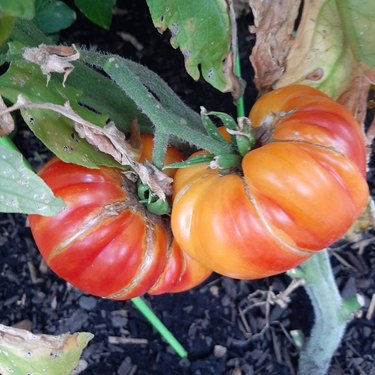
If you're talking heirloom tomatoes, you're talking a rainbow of colors, a cornucopia of shapes and sizes, and the prestige of a long and illustrious history. Heirlooms — not just tomatoes but all heirloom plants — are distinguished by seed that has spanned generations of growers.
I'm obsessed with heirloom tomatoes, I'll admit. And, as exotic as they seem, they are easy to grow, so the payoff is great. They germinate well, they quickly put on girth and size, and they transplant easily.
Video of the Day
Video of the Day
Before getting started as a grower of heirloom tomatoes, it's a good idea to learn the basics and to research different types of heirlooms — not just their size, shape, and color, but also their flavor, their growing needs and characteristics, and whether they're suitable for your climate and garden.
What Are Heirloom Tomatoes?
The term "heirloom" doesn't have a precise definition, but what it's not is hybridized. Let's break this down.
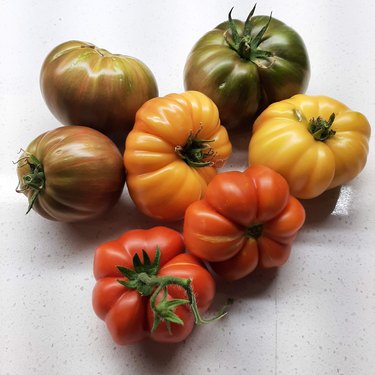
Heirlooms Span a Generation or More
Think 50 years. That represents multiple generations of not only seed development but families and friends growing and sharing their precious seeds. Fifty years is usually considered the minimum time required for a variety to be considered "heirloom." Various experts and tomato aficionados differ, however, on this time frame. Some say only 25 years, while others assert that any variety that appeared after World War II cannot be an heirloom, and therefore, any tomato that calls itself heirloom must have been around before 1940.
Heirlooms Are Open-Pollinated
Disputes about age aside, everyone agrees that heirlooms must be open-pollinated. That means that they are pollinated naturally from the pollen of other tomato plants of the same variety and that their seeds will produce the exact same plants as the parent. This distinguishes them from hybridized tomatoes, in which plant breeders cross-pollinate two different types of plants in an attempt to create a third variety with the best characteristics of both.
Heirlooms (Usually) Look Different
Heirloom tomatoes often have a distinctive look and typically are not uniform in size or color. In fact, their shape is often bulbous and irregular, with deep clefts and creases. They may be homely, in fact. But this is part of their charm!
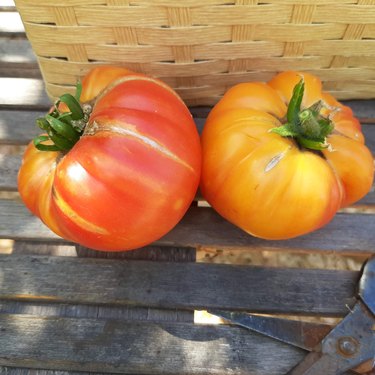
Heirlooms May Be Less Disease-Resistant
Because they have not been specifically bred to develop immunity against certain diseases, some heirloom tomatoes are more prone to disease than some hybrids. Heirlooms also sometimes produce less fruits per plant.
But that's not always the case. Many heirlooms are heavy producers and quite disease-resistant, so it pays to do some research before choosing your varieties.
Tip
Choose tomato varieties that are known to do well in your area. You can find these by perusing seed catalogs from local companies and getting recommendations from local authorities such as university extensions.
Types of Heirloom Tomatoes
Most conventional tomatoes are red, and only red. But why settle for a single color when you can have purple, almost-black, green, yellow, orange, and variegated in multiple shades — even green zebra? Just keep in mind that color doesn't necessarily determine flavor.
Heirloom tomato varieties fall into the same basic categories as other tomatoes:
- Determinate or indeterminate: Sometimes called bush tomatoes, determinate varieties stop growing after setting what is called the "terminal bud" and then go on to produce all their fruit at the same time. Indeterminate varieties are sometimes called vine tomatoes and can reach almost any height depending on the growing season and other factors. They produce fruit throughout the growing season, stopped only by cold weather. While most heirlooms are indeterminate, some varieties are indeed determinate.
- Slicing or cherry: You want 'em in a sandwich, sliced? Or do you want to munch on them in the garden or anytime by popping a small, delectable fruit into your mouth? Heirlooms come in all sizes.
- Short or long growing season: Often referred to on a seed packet or tag as "days to maturity," this is an important characteristic to be aware of. Anything under 70 days is considered "short" and is therefore a good choice in northern climes with shorter growing seasons.
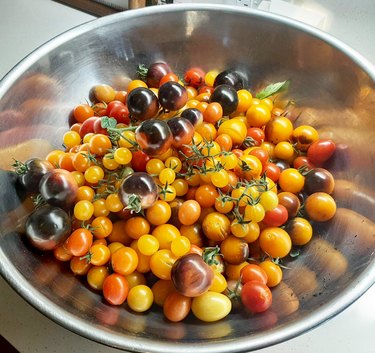
I have a teensy, tiny greenhouse that can, however, accommodate about 150 plants, and I make sure to stuff it with multiple varieties each year. I have faves that I just have to grow no matter what, but I always peruse the seed catalogs during winter and find new, fascinating varieties to try.
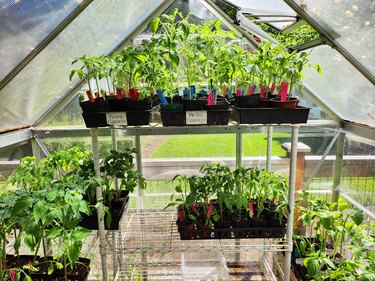
Choosing Heirloom Tomato Varieties
As with all tomatoes and plants, you can grow them from either seed or purchased seedlings. Seedlings (a.k.a. starts) are always less complicated, requiring less work and allowing you to depend on others' expertise when you're first starting out — so if you can find heirloom tomato starts you'd like to try, that's a great initial step.
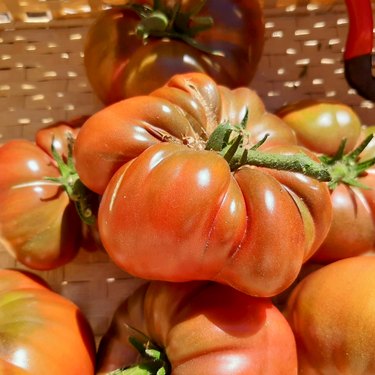
Finding Heirloom Tomato Starts
With seedlings, your choice is limited by availability. Some common heirloom tomato starts are often available at nurseries and some even at big-box stores. You might see Cherokee Purple, a popular dark slicing tomato with amazing flavor. Or, depending on where you live, you might find Brandywine, a lovely beefsteak with a pinkish color, or even Pineapple, Black Krim, or Green Zebra, all of which have become more well-known.
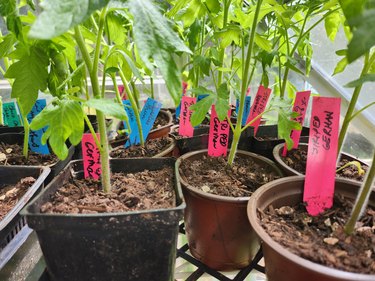
Some specialty nurseries may carry other less common varieties. Farmers' markets are a good place to try, and you can always ask the vendors if they will consider growing more tomato varieties in future years, so they can be a great source.
Selecting Tomato Varieties
Because heirloom tomatoes can be a little more finicky than hybrid tomatoes, do some research and get the help of local experts when selecting tomato varieties. Trying to grow heirloom tomatoes that thrive in the muggy, hot areas of Mississippi when you're in the Pacific Northwest could be an exercise in failure.
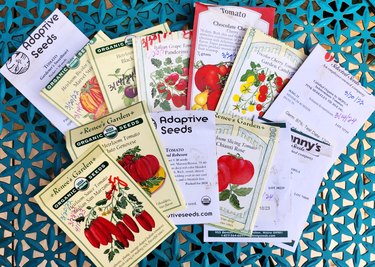
Your local university extension office and regional seed companies are excellent sources for finding heirlooms that are recommended for your area. For example, an internet search for "best heirloom tomato varieties in Mississippi" yields multiple discussions on regional varieties from the Mississippi State Extension Service and from other sources. A similar internet search for Colorado also returns useful results, so plug in your state and see what you find.
Tip
Choose heirlooms recommended for your region. While heirloom tomatoes haven't been hybridized, they have acclimated to the areas where they have been bred and therefore have inbred environmental preferences.
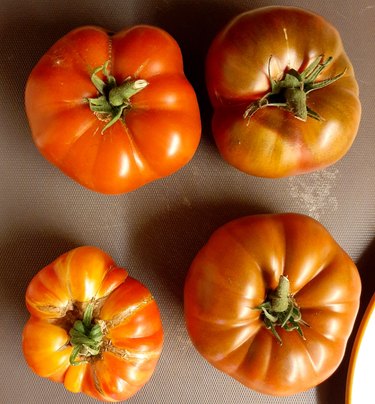
Growing Heirloom Tomatoes From Seed
The best way to try a range of heirloom tomatoes is to grow them from seed because then the world is your proverbial oyster. Again, try to find regional seed companies that produce heirloom seeds tested and known to grow in your area. I live in Eugene, Oregon, and I am lucky to have multiple local seed producers — you might too.
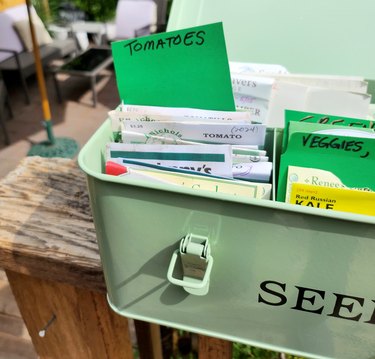
No Greenhouse? Use Grow Lights
You don't need a greenhouse, but you must have a way to provide light and warmth to your sprouting seeds and seedlings until you can plant them outside because tomatoes love it warm.
Growing with lights is, however, a science as much as any other method of cultivation, and it has everything to do with the intensity of the light and how far away it is from your plants to make sure they get just enough light but not too much. This means continuously adjusting the level of the lights as the plants grow, so be sure to thoroughly research using grow lights if you use this method.
When and How to Plant Heirloom Tomato Seeds
Planting time is exciting! Eight weeks before your area's last frost date is the time. For me, this is about March 15.
Tip
Don't try to plant tomato seeds directly in the garden in what you think is a protected area, such as under a cloche or seed row cover. These products might work for seedlings, but all they do is protect a plant from freezing. First, the seeds need to germinate, which requires temperatures of 65 to 85°F.
Germinate seeds somewhere warm (in your house is perfect). Once germinated, they need warmth to grow and put on size, so they still need somewhere warm that's about 70°F. Most important, however, is that they'll need light immediately, so be ready with either your grow lights or greenhouse.
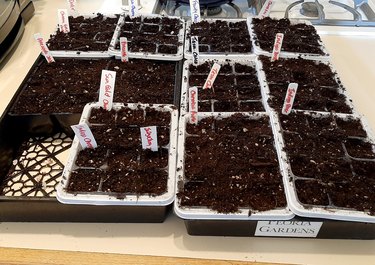
Planting Procedure
- Prep the pots and potting soil. Clean any old pots you plan to use or buy new ones; then, get some sterile potting mix. (This is important because you can introduce disease with used pots and old potting soil.) Never use regular garden soil. I always use six-pack pots rather than seed trays, but you can use either. The advantage of pots is that you disturb the roots less when you transplant them.
- Sow the seeds. Sow two to four seeds per potting cell about 1/2 inch deep. Cover with soil and firm.
- Keep them moist. Mist with a mister to moisten the seeds. Don't use a watering can or hose because you can easily dislodge the seeds with a strong stream of water.
- Wait until they germinate! They don't need light to germinate, so you can set them anywhere. (They take up a lot of space on my kitchen counter each spring!)
Caring for Your Seedlings
The key ingredients are sun, warmth, and fertilizer in addition to water, of course. If you can provide these, your tomato starts will jump out of their pots.
Tip
Light is so important! This can't be emphasized enough: Tomatoes need a lot of light. You'll know they have too little if they become thin and spindly as they grow.
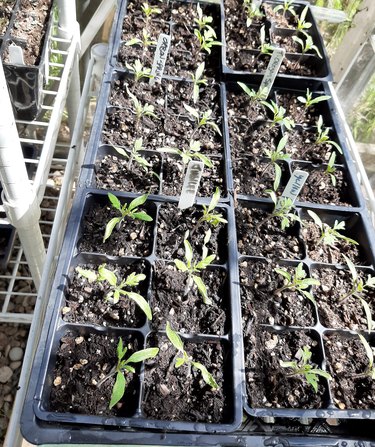
This is my regimen:
- Keep them moist. I water them with a spray bottle so I don't wash away the seeds with a too-strong spray. Never let them dry out but don't soak them either.
- Provide sun. After germination, I stick them in a sunny window for a day or two (no longer!) while I prep the greenhouse.
- Prep the greenhouse (or grow lights). I set up an old space heater in a dry corner. Make sure it's not a place that will get wet!
- Move the germinated seedlings to the greenhouse. I gather my trays and take them out to the shivery outdoors and then into the toasty greenhouse, where I set them on their shelves so they can receive full sun.
- Foliar feed at two weeks. At two weeks, I prep a watering can with a mixture of fertilizer. I use an all-purpose liquid mixture of 4-1-3, adding about 1 tablespoon per gallon. I water them daily with this mixture. (Note that some growers believe this is too much fertilizer for small plants. All I can say is that my plants jump out of their pots and look great.)
- Transplant into individual pots. At about one month or when they are perhaps 2 to 3 inches tall, I transplant each of them into 4-inch pots. I again use new, unused potting soil.
- Continue foliar feeding daily. I continue to water them with the liquid fertilizer daily.
- Plant them in the garden. At about eight weeks, they are ready to go outside. For me in Eugene, Oregon, this is May 15. This depends on your last frost date, of course. Never, ever put your plants outdoors before that unless you protect them.
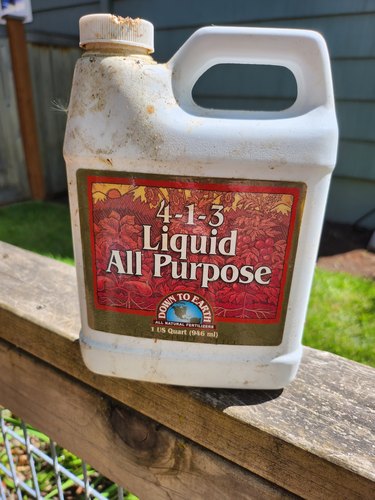
Seasonal Care for Heirloom Tomatoes
All tomatoes, whether heirloom or not, are heavy feeders. When you plant, add a good amount of compost and manure to the planting hole and then side-dress them during the growing season every four to six weeks with a water-soluable, balanced solution.
Tomato care is an extensive topic and not part of our subject today. But if you run into disease problems or need general advice, your local extension office is the place to start.
Harvesting Heirloom Tomatoes
You might think that harvesting your tomatoes is the easiest part of growing them — but this is not necessarily so! The best information I've found on how to know when to harvest is from the seminal book written by Craig Lehoullier titled Epic Tomatoes. If you get bitten by the heirloom tomato bug, this book will be your bible.
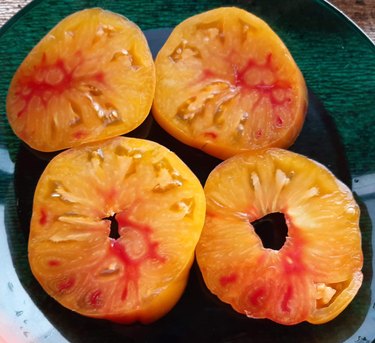
On Tomato Color
Consider these interesting factoids about tomatoes, grabbed from Lehoullier's book:
- Tomato color is based on two things: their skin color and their flesh color. The skins of tomatoes are either clear, yellow, or striped. The flesh has more variety and ranges from yellow, orange, red, and red-yellow bicolored to green, as with the "black" tomatoes. How these colors combine affect the color of the fruit throughout the growing season as well as at harvest time.
- The color a tomato is known by (red, pink, purple, green, bicolored, yellow, or orange) is based on the flesh, not the skin. This means that the Cherokee Green tomato, which has yellow skin and green flesh, will appear a deep yellow when ripe, but when sliced, it will be green inside.
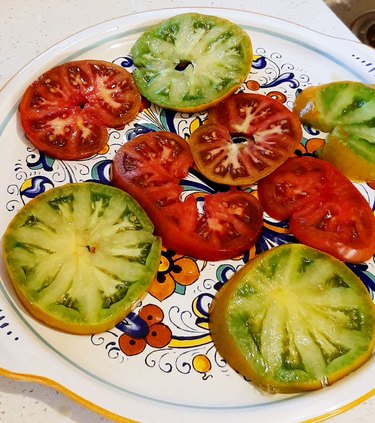
Color does not indicate harvest-readiness. Sometimes, experimentation is best. If you think your tomato variety is getting close to harvest, pick one and taste it. Take notes and perhaps even pictures so you will recognize its color if you grow it again. Then, a few days later, pick another.
Tomatoes will generally be more tart in the early stages of ripeness compared to the later stages when they develop more sweet flavors.
Tip
It definitely pays to know your varieties when it comes to harvest time. All red tomatoes, for example, don't ripen to the same color, so find out what your varieties are expected to do.
Harvesting Tomatoes Based on Color
Here's a super-short summary from Epic Tomatoes.
- Red tomatoes. You know the rub here (I mean, these are red tomatoes, familiar to us all), but there can be a catch. Some red tomatoes never go completely red, retaining that green tinge on the stem end.
- Purple or black tomatoes. These dark tomatoes can retain some green pigment when ripe, so you might see a green color overlaying a deeper red. Some varieties have clear skin, which will make the fruit look more purple, while some have yellow skin, resulting in a brown, chocolatey color.
- Pink tomatoes. Pink tomatoes have deep pink or red flesh just like red tomatoes, but their skin color is clear, while red tomatoes' skin is yellow. They generally turn a deep pink when ripe.
- Yellow or orange tomatoes. Here, you have to know your variety so you know the expected color when ripe. It may vary from a somewhat pale yellow to a soft or deep orange.
- Green tomatoes. These may have either yellow skin or clear skin. The yellow-skinned varieties, including Cherokee Green, are a golden yellow when ripe, but the clear-skinned types (Aunt Ruby's German Green, for instance) stay fully green even when ripe. These latter types may develop a faint pink blush at the blossom end and may warm up slightly in color.
- White tomatoes. These may be an ivory color when ripe, although that will depend on whether the fruits were in direct sun or hidden by foliage.
- Bicolored tomatoes. These tomatoes vary so much that different fruit on the same plant will have entirely different patterns. Usually, the red stripes turn a deeper shade when ripe. Again, know your variety.
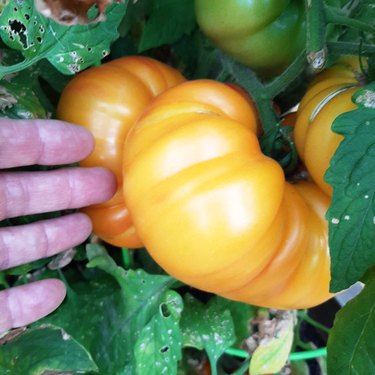
Tip
Temperatures also matter when it comes to harvest time. Warm temperatures may deepen the colors, but very hot temps, such as in the 90s, can actually scald tomatoes and make their skin appear paler.
